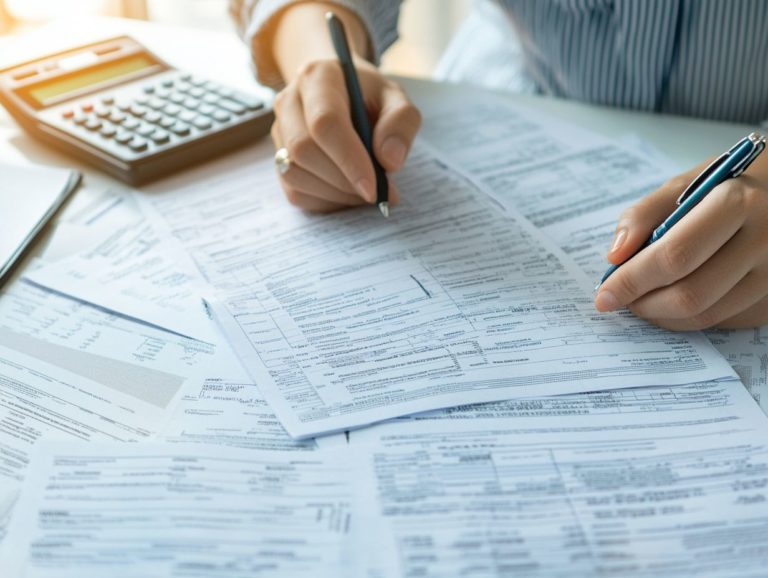How to Create a Savings Plan for Freelancers
Freelancing offers flexibility and independence, but it also comes with financial uncertainty. A solid savings plan is essential for managing irregular income and unexpected expenses.
Let’s dive into why a solid savings plan can change your freelance game! This article also offers actionable advice on how to create a savings plan, stick to it, and adjust it as needed. We encourage you to follow along to ensure that your freelance career remains financially healthy.
Contents
Key Takeaways:
- Protect your income with a solid savings plan that prepares you for financial fluctuations.
- Track your earnings and expenses to assess your financial situation and set achievable goals.
- Implement strategies for saving money and regularly allocate funds to your savings. Stay on track by monitoring and adjusting your plan as needed.
The Importance of a Savings Plan
A well-structured savings plan is essential, serving as a guiding framework for financial planning and decision-making. This plan enables freelancers to navigate the uncertainties of freelance income while establishing a sustainable livelihood.
With the growth of freelancing jobs, it’s important for freelancers to develop good saving habits to achieve financial success, manage cash flow, and secure their retirement savings. This can be accomplished through a robust savings account and an adaptable investment portfolio that accommodates varying income streams.
Why Freelancers Need a Savings Plan
Freelancers often experience unpredictable income, making a savings plan essential for maintaining financial stability and preparing for unexpected expenses. This variability in cash flow creates significant pressure, as clients may not always pay on time, and future projects can be uncertain.
Without a proper budget, it is easy to overspend during prosperous times and struggle during lean periods. A solid savings plan enables freelancers to build a financial cushion, ensuring they can cover essential needs when income is low.
This financial security allows freelancers to concentrate on their work rather than worry about immediate financial concerns, ultimately helping them achieve their long-term financial goals.
Assessing Your Income and Expenses
Assessing income and expenses is the fundamental step for freelancers to achieve financial stability and success. This evaluation helps them understand cash flow and net income, both of which are essential for maintaining a healthy budget.
Tracking Your Earnings and Spending
Tracking earnings and spending is essential for freelancers to effectively manage their cash flow and make informed financial decisions. Utilizing various tools and applications designed to monitor income and expenses enables individuals to better handle online money transactions.
A well-chosen combination of budgeting applications, expense tracking apps, and other financial management solutions provides valuable insights necessary for maintaining financial health. Automating the tracking process and categorizing transactions enhances accuracy while reducing the likelihood of human errors.
Additionally, regularly analyzing the tracked data is vital, as it helps freelancers identify their spending habits and adjust their budgeting plans accordingly. This approach lays the groundwork for improved financial forecasting and planning, both of which are crucial for achieving long-term financial success.
Setting Financial Goals
Setting clear financial goals enables freelancers to enhance their budgeting and savings strategies by providing a roadmap that guides them toward their desired financial outcomes and improves their retirement savings.
Start tracking your income today and set clear financial goals to boost your savings strategy!
Short-Term and Long-Term Goals
Freelancers need both short-term and long-term financial goals to effectively manage their finances. These goals enable them to meet immediate needs while planning for the future, such as retirement savings and investments.
For instance, short-term goals might involve ensuring they have enough funds for an emergency fund or saving for a new laptop to enhance work efficiency. In contrast, long-term goals could include contributing to an IRA or saving for their dream home.
These objectives should be integrated into a broader savings plan, acting as a guiding document to help independent workers navigate their unique financial situations. Periodically reevaluating these goals is essential, as financial circumstances can change due to income fluctuations or unexpected expenses, and priorities may shift. Adjusting goals is crucial for maintaining ongoing financial health.
Creating Your Savings Plan
A savings plan is an essential part of a freelancer’s financial strategy. It helps develop healthy saving habits while preparing for future investments and ensuring financial security.
Strategies for Saving Money
Implementing effective money-saving strategies is vital for freelancers looking to enhance their financial well-being. These strategies can help build savings in a dedicated account and set aside funds for retirement.
By combining traditional methods, such as high-yield savings accounts and meticulous expense tracking through budgeting, with innovative tools like apps that round up purchases to save the difference, freelancers can establish a solid financial foundation.
Financial advisors recommend setting up a dedicated account specifically for taxes, alleviating the burden of tax payments at year-end. Utilizing retirement accounts designed for the self-employed, such as Solo 401(k)s or SEP IRAs, offers additional tax benefits while building a nest egg.
Looking into different ways to invest can further enhance savings and contribute to long-term financial stability.
Allocating Funds for Savings
Saving money is vital for freelancers—it sets the stage for a secure future! It involves dedicating a portion of their income to both short-term and long-term retirement savings. One option for achieving this is to establish a tiered savings system that prioritizes essential needs while also allocating funds for long-term expenditures.
Another approach is to follow the 50/30/20 rule, which suggests allocating 50% of one’s income for needs, 30% for wants, and 20% for savings.
Utilizing budgeting tools, such as apps, can assist in tracking expenses. They provide a visual representation of spending habits and enable freelancers to adjust their allocations accordingly. This balancing act helps create a secure financial foundation and allows individuals to plan for future goals, ensuring financial stability despite unpredictable income.
Sticking to Your Savings Plan
Adhering to a savings plan fosters discipline in financial decisions and helps freelancers consistently work towards their financial goals, even when income fluctuates.
Tips for Staying on Track
Freelancers can adopt various methods to adhere to their savings plans, which promote budget compliance and enhance cash flow management. Regularly reviewing financial goals and tracking expenses allows them to identify areas requiring adjustments to their plans.
Utilizing budgeting apps or spreadsheets offers clear insight into spending habits. Setting up automatic transfers to savings accounts ensures that a portion of income is consistently saved.
Small celebrations for achieving milestones, whether related to savings or a month of sticking to a budget, can boost motivation. Encouragement and check-ins with fellow freelancers create a supportive environment, making the financial journey feel less isolating and more collaborative.
Adjusting Your Savings Plan
For freelancers, regularly updating their savings plan is essential. It enables them to assess their financial situation and adjust their plans to align with fluctuating income levels and expenses.
Start your journey to financial freedom today! A well-structured savings plan is crucial for achieving your financial goals.
Reassessing and Modifying as Needed
For freelancers, it’s essential to regularly reassess and modify their savings plans. This ensures that their financial goals remain realistic and that their budgets effectively meet changing financial needs.
Freelancers often have variable incomes, making frequent evaluations of their savings plans necessary. Unexpected changes in projects, fluctuations in demand for services, or shifts in personal circumstances can all affect financial security.
A noticeable change in income, whether positive or negative, should prompt a review of savings plans. Major life events, such as marriage, having children, or illness, can significantly alter financial priorities.
Therefore, having a dynamic and flexible financial plan enables freelancers to adjust their strategies based on these indicators. This flexibility is crucial for maintaining a strong financial foundation amid uncertainty.
Frequently Asked Questions
What is a savings plan for freelancers?

A savings plan for freelancers is a financial strategy designed to help self-employed individuals save money for future expenses, taxes, and retirement. It involves regularly setting aside a portion of income to build a financial safety net and achieve stability.
Why do freelancers need a savings plan?
Freelancers do not have a steady paycheck and are responsible for managing their finances, including taxes and retirement savings. A savings plan helps freelancers budget and save for unexpected expenses, periods of low income, and retirement. It also provides peace of mind and financial security.
How do I create a savings plan as a freelancer?
The first step is assessing your current financial situation. Determine your income, expenses, and savings goals. Then, set a realistic budget and decide how much you can save each month. Create a separate savings account and set up automatic transfers to make saving easier. Regularly review and adjust your plan to ensure it aligns with your financial goals.
Can I save for retirement as a freelancer?
Absolutely! Freelancers can choose from several options to save for retirement, such as individual retirement accounts (IRAs, which are tax-advantaged accounts for retirement savings), solo 401(k)s, or SEP IRAs (Simplified Employee Pension Individual Retirement Accounts). These retirement plans offer tax benefits and allow freelancers to save for a secure future while reducing taxable income. Start saving for retirement today!
How much should I save as a freelancer?
There is no one-size-fits-all answer to this question, as the amount you should save depends on your income, expenses, and financial goals. As a general rule, it’s recommended to save at least 20% of your income for taxes and retirement and maintain 3-6 months’ worth of expenses in an emergency fund. Consult with a financial advisor to determine the best savings plan for your specific situation.
What are some tips for sticking to a savings plan as a freelancer?
One tip is to set specific and achievable savings goals. This helps motivate you to stay on track and see progress. Another tip is to automate your savings by setting up automatic transfers to your savings account. Tracking your expenses and finding ways to cut costs can also help you save more. Finally, stay disciplined and committed to your plan, even during periods of low income.









